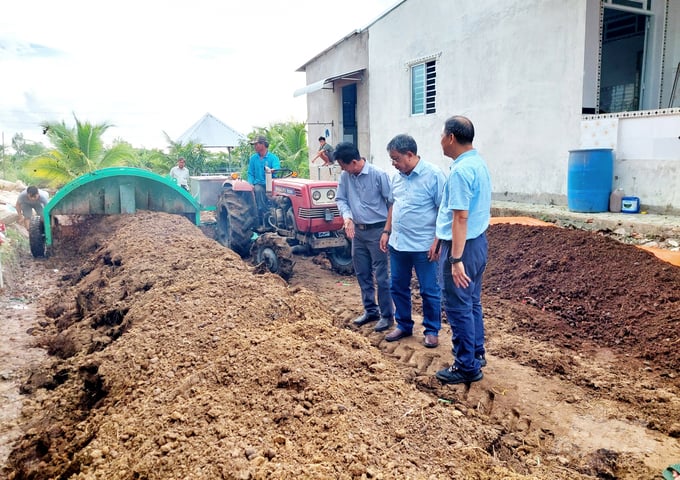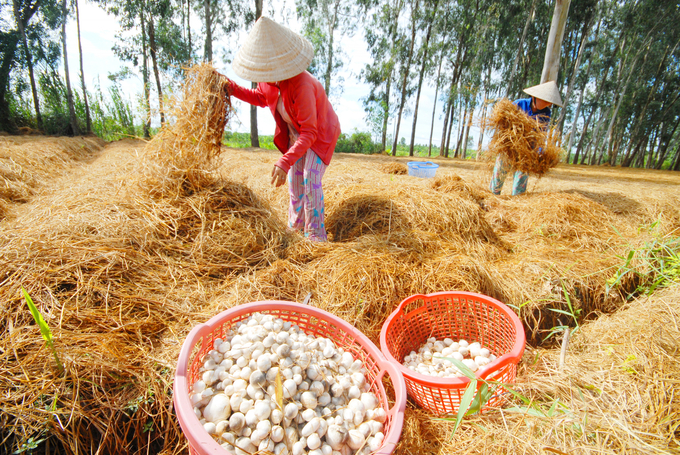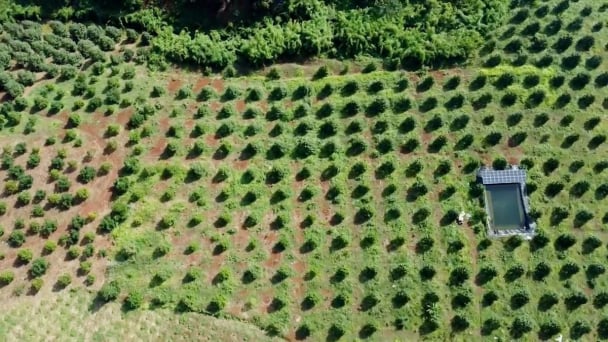May 31, 2025 | 22:52 GMT +7
May 31, 2025 | 22:52 GMT +7
Hotline: 0913.378.918
May 31, 2025 | 22:52 GMT +7
Hotline: 0913.378.918

The total volume of agricultural by-products is over 156.8 million tons annually. Photo: Le Hoang Vu.
Agriculture plays a significant role in the economy to help stabilize society, especially during the recent outbreak of the Covid-19 pandemic. Export of agricultural, forestry and fishery products in 2021 reached a record high of over US$ 48.6 billion. Total export turnover of agricultural, forestry and fishery products in the first 6 months of 2022 reached US$ 27.88 billion, up 13.9% and aiming to reach about US$ 55 billion in 2022.
However, agricultural production also generates many by-products, which, when improperly managed, will cause environmental pollution and waste organic matter.
According to the Department of Science, Technology and Environment (Ministry of Natural Resources and Environment), the whole country's total volume of agricultural by-products in 2021is over 156.8 million tons, including 88.9 million tons of the following by-products after harvesting from crops and the processing of agricultural products of the crop industry (accounted for 56.7%), 61.4 million tons of cattle and poultry manure from the livestock industry (accounted for 39.1%), 5.5 million tons from forestry (accounted for 3.5%) and about 1 million tons from fisheries (accounted for 10.6%).
With a circular agricultural economy associated with green growth, by-products in agriculture, forestry and fishery must be considered a renewable resource, not a waste. This source of raw materials should be viewed as an essential input, extending the value-added chain in agriculture.
Eco-Fair project's Director Nguyen Bao Thoa, Vietnam Institute of Agricultural Research and Development VIRI, shared that crop by-products in Vietnam have the most significant volume in agricultural by-products.
Post-harvest crop by-products from rice straw account for a large volume of 42.8 million tons, corn stalks for 10 million tons, vegetables and fruits for 3.6 million tons, cassava stalks for 3.1 million tons, fake fruit and seeds for 3.1 million tons and others with 6.1 million tons...
By-products from the processing of agricultural products of the horticulture industry include 8.6 million tons of rice husks, 3.5 million tons of bagasse, 1.4 million tons of corn cobs, 1.3 million tons of cassava husks, and 2 million tons of assorted other. In the actual situation of using crop residues, the percentage of crop by-products (peanut shells, corn stalks, rice straw, cassava stalks, firewood, etc.) collected and used accounts for only 52.2%.

Mekong Delta farmers take advantage of rice straw to compost mushrooms, contributing to increasing households' income. Photo: Le Hoang Vu.
In Vietnam, 70% of the population is engaged in agriculture, and rice is the main crop. Therefore, the amount of straw after harvest is enormous, estimated at nearly 46 million tons per year. The rate of using rice straw is only 56.3% (to make raw fodder for grazing cattle, as filler for livestock, as biological padding for livestock, as straw mushrooms, root mulch for plants, lining fruits, etc.). At present, there are still some places, after harvesting rice, farmers have the habit of burning rice straw right in the field, causing air pollution, obstructing traffic, and affecting human health.
Dr. Trinh Quang Khuong, Mekong Delta Rice Institute, said that now, after the rice harvest seasons in the Mekong Delta, the market for rice straw collection, packaging, transportation, and trading in the Mekong Delta region is growing strongly. In the winter-spring crop in 2021 in Dong Thap province, An Giang, the selling price of straw is about VND 55,000-75,000 per 1,000 m2 of field, equivalent to VND 400 per kilogram, the price of straw next to the inter-commune road is VND 15,000 per bundle, equal to 1,250 VND per kilogram.
If transporting far, the selling price of straw at the establishment used for cattle raising, mushroom making, and gardening... is about VND 25,000 per bundle, equivalent to VND 2,083 per kilogram. Thus, rice farmers, in addition to harvesting rice, after harvesting, they can also collect an average of VND 550,000 per hectare of straw sold.
Annually, the biomass of agricultural by-products from main crops such as rice, corn, sugarcane, and vegetables of all kinds can provide the equivalent of about 43.4 million tons of organic matter, 1.86 million tons of urea nitrogen, 1.68 million tons of single superphosphate and 2.23 million tons of potassium sulfate… It is considered a vast number to offset nutrients in the soil and use for crops in agricultural cultivation to adapt to climate change.
However, these nutrients are almost wasted, and there are no incentive mechanisms for reuse. Currently, in the process of fruit production, collection, and processing in the Mekong Delta, the Southeast region... the number of mango seeds, banana peels, durian skins, jackfruit skins... is a lot. Still, many places are wasting it, even also pollutes the environment.
Translated by Ha Phuc

(VAN) Several scientists and farmers are experimenting with soil treatment in some key durian-growing regions such as Cai Lay (Tien Giang), Dak Song, Gia Nghia, and Dak R’lap (Dak Nong).
/2025/05/25/4127-3-073637_820.jpg)
(VAN) Thanks to the promotion from an FAO-implemented project, vegetable production in greenhouses in Moc Chau has seen strong development, from 1.5 hectares in 2021 to nearly 50 hectares in 2024.

(VAN) FAO has recently supported USD 140,000 to implement the project 'Risk mitigation human-animal interface risks through disease control initiatives in pig farming.'

(VAN) The People's Committee of Tra Vinh province has approved an adjustment to the investment policy for the Green Hydrogen Plant project, increasing its area to approximately 52.76 hectares.
![Reducing emissions from rice fields: [2] Farmers’ commitment to the soil](https://t.ex-cdn.com/nongnghiepmoitruong.vn/608w/files/news/2025/05/05/dsc08881jpg-nongnghiep-140632.jpg)
(VAN) Clean rice cultivation model in Thuong Tan commune, Bac Tan Uyen district, is assisting local residents in achieving sustainable agriculture by substantially reducing costs, increasing productivity, and protecting the environment.

(VAN) At the conference to disseminate Resolution No. 68, AgriS introduced its digital agricultural ecosystem and reaffirmed its commitment to accompanying the Government in promoting private sector development and sustainable agriculture.

(VAN) 'Blue Ocean - Blue Foods' initiative is designed to restore marine ecosystems and establish sustainable livelihoods for local communities by cultivating a minimum of 1,000 hectares of cottonii seaweed in the first three years.